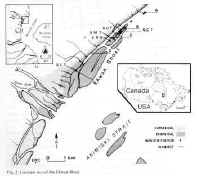Sedimentary Geology, 37 (1983/1984), 273-294
SEDIMENTOLOGY OF THE EKWAN SHOAL, AKIMISKI STRAIT, JAMES BAY, CANADA
D.F. GRINHAM and I.P. MARTINI
Department of Land Resource Science, University of Guelph, Guelph, Ont. NlG
2Wl (Canada)
¡¡
 One of the steepest depositional coasts of western James Bay is found along
the west shores of Akimiski Strait, north of the mouth of the Ekwan River. This
shore receives considerable amounts of sediment during the spring break-up of
the rivers. The sediments are stored on the steep narrow tidal flats and
marshes, and in thinner (up to 80 cm) drapes on till-cored shoals that parallel
and protect the coast. The low areas between the shoals and the mainland are
swept and reworked by relatively powerful (2 m S-1) reversing
currents due to flooding and ebbing of tides into the strait.
One of the steepest depositional coasts of western James Bay is found along
the west shores of Akimiski Strait, north of the mouth of the Ekwan River. This
shore receives considerable amounts of sediment during the spring break-up of
the rivers. The sediments are stored on the steep narrow tidal flats and
marshes, and in thinner (up to 80 cm) drapes on till-cored shoals that parallel
and protect the coast. The low areas between the shoals and the mainland are
swept and reworked by relatively powerful (2 m S-1) reversing
currents due to flooding and ebbing of tides into the strait.
A series of distinct environments and sedimentary facies
develop on this western coast and its antecedent longshore shoal. The outer part
of the shoal is characterized by tidal bedding, Macoma balthica burrows
and considerable ice scour. The inner part of the shoal has winnowed sand, the
greatest abundance of Macoma, and well-developed flaser bedding. The
longshore tidal channel separating the shoal from the mainland has coarse sand
lags in the shallower parts and silty sand in deeper protected areas. The steep
tidal flats develop laminated silty sands locally saturated and slumping toward
the channel. The high saturation of the sediments inhibits colonization of the
flats by Macoma. The narrow marshes have characteristic vegetation
zonation, with Puccinellia phryganodes colonizing the lower marsh. The
sedimentary sequence of the marsh displays irregular, bioturbated laminated
sequences of silt, silty sand and organic matter.